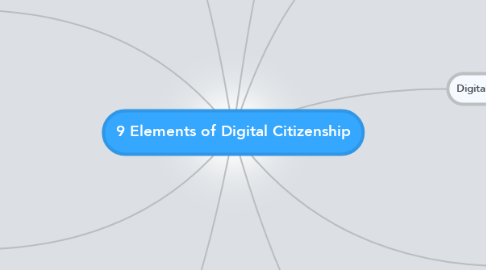9 Elements of Digital Citizenship
by Raina G.

1. Digital Access
1.1. D: Full electronic participation in society
1.2. a. A teacher gives an assignment to a class that needs internet and gives them time during class. So everyone has internet.
1.3. i. A teacher gives assignment to a class the needs internet and does not give them time in class so they have to do it at home but only some of the kids have internet at home.
2. Digital Commerce
2.1. D: the buying and selling of goods online
2.2. a. Dave bought a shirt on the oringinal website for the full amount of money, and he gets the shirt. Dave knows the safety of online shopping.
2.3. i. Dave bought a shirt on a counterfeit website for less but did not get his shirt. Dave did not know the safety of online shopping.
3. Digital Etiquette
3.1. D: the standards of conduct expected by other digital technology users
3.2. a. Sally was at the mall and she took a picture of her and her friend with someone in the backround who was not paying attention and deleted it.
3.3. i. Sally was at the mall and she took a picture of her and her friend with someone in the backround who was not paying attention but still put it on.
4. Digital Communication
4.1. D: the electronic exchange of information
4.2. a. Sally was on a chat website and met a new person asking her personal question. So Sally walked away and told her parents. Sally did the right thing by walking away and telling her parents
4.3. i. Sally was on a chat website and met a mew person who was asking her personal question. Sally sat and answering him. But when she felt that it went to far it was to late and she gave out to much information. Sally was not being safe online.
5. Digital Law
5.1. D: The legal rights and restrictions governing technology use.
5.2. A: Bob went home and played on his computer from 5 to 6.
5.3. I: Bob went home and played on the computer from 5 to 9.
6. Digital Rights and Responsibilities
6.1. D: The priveliges and freedoms extended to all digital technology users, and the behavioral expectations that come with them.
6.2. A: Samantha took a picture at the park with someone in the background. She later deleted it because she did not have permission to post the picture.
6.3. I: Samantha took a picture at the park with someone in the background. She later posted the picture on her profile without the permission of the stranger.
7. Digital Health and Wellness
7.1. D: The elements of physical and psychological well-being related to digital technology users.
7.2. A: Robert is playing outside instead of being cooped up in his room playing on the computer, listening to music, and texting his friends all day.
7.3. I: Robert stays home all day in his room playing on the computer, listening to music, and texting his friends. Robert is losing communication skills with all this technology and is not getting exercise.
8. Digital Security
8.1. D: The precautions that all technology users must take to guarantee their personal safety and the security of their network.
8.2. A: Kathy makes her profile private so no one else but her friends she accepts can see what she posts.
8.3. I: Kathy is on her computer, posting personal information to her profile that anybody can go on her profile and see it.
9. Digital Literacy
9.1. D: The capability to use digital technology and knowing when and how to use it.
9.2. A: Emily goes and talks to her boss in person instead of emailing her and messaging her through technology all the time.
9.3. I: Emily doesn't like socializing with people in person. She would rather message and email her boss what she wants to tell her. Emily's boss does not like Emily's socializing problem so she talks to her about it.


